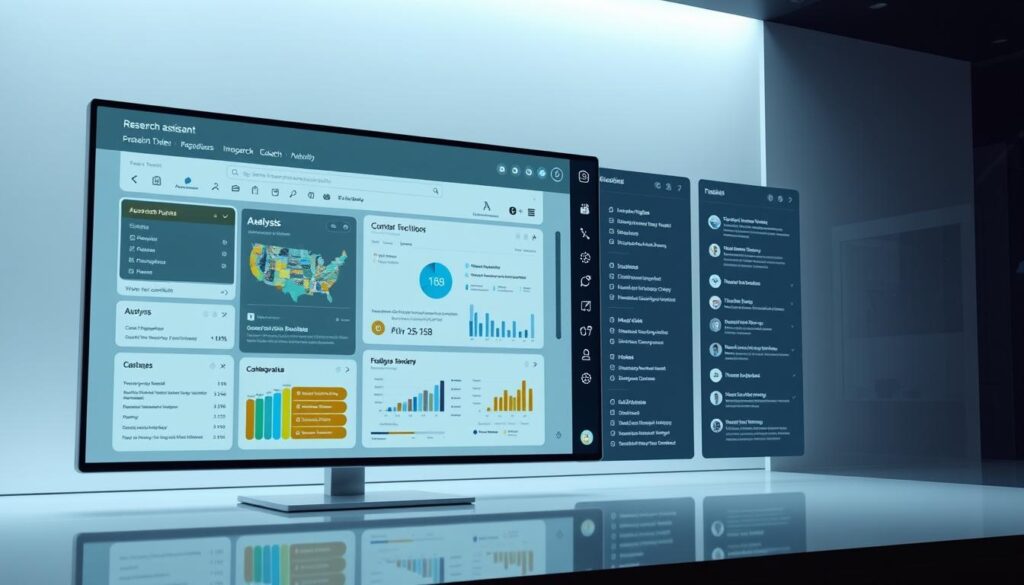Discover top-rated Best AI Tools For Academic Literature Review that streamline research, save time, and help you create comprehensive scholarly analyses with accuracy.
Academic research has changed a lot with AI tools. As a researcher, I’ve found amazing platforms that make finding and analyzing scientific papers easier.
Finding research can be hard. Now, tools help researchers access over 200 million papers in many fields. I’ve seen how AI cuts down the time needed for searching.

AI is changing how we find, analyze, and put together research. These tools use smart algorithms to suggest papers, find important points, and help us go deeper into our studies.
Key Takeaways
- AI tools can process millions of academic papers rapidly
- Advanced platforms offer intelligent research recommendations
- Researchers can save significant time using AI-driven search technologies
- Multiple disciplines benefit from AI literature review tools
- Critical evaluation remains essential when using AI research assistants
Understanding the Role of AI in Academic Research
As a researcher, I’ve seen a big change thanks to AI tools. These new technologies are changing how we do literature reviews. They make it faster and better in many fields.

AI tools are changing academic research a lot. They offer new ways to make research easier. Here are some key benefits:
- Automated paper scanning across thousands of publications
- Intelligent extraction of critical research findings
- Real-time translation breaking international research barriers
- Advanced pattern recognition in complex datasets
Powerful Benefits of AI-Powered Literature Reviews
AI brings big advantages to research. It can quickly sort through lots of data. AI uses smart algorithms to find important points and reduce mistakes.
Limitations and Possible Risks
But AI tools also have challenges. Researchers must stay careful. AI helps, but it can’t replace human thinking. There’s a risk of bias and too much trust in machines.
Current State of AI Research Tools
AI research is growing fast. Tools like Semantic Scholar, Research Rabbit, and Consensus are leading the way. They offer advanced features that change how we study and understand research.
AI is not just a tool, but a collaborative partner in academic research.
Best AI Tools For Academic Literature Review

As a researcher, I’ve found five amazing AI tools for literature reviews. These tools can change how you do research. They save time and make your reviews better.
Here are the top tools for academic research:
- Elicit: A cutting-edge research assistant that searches over 200 million papers from the Semantic Scholar database
- Consensus: An AI-powered platform that uses GPT-4 to summarize top studies
- Research Rabbit: A visual exploration tool for academic literature
- Litmaps: A sophisticated citation network analysis platform
- Copilot: An advanced AI research companion
Each tool has special features for research. Elicit can scan up to 3600 PDFs for info. Research Rabbit lets you set alerts for new papers and work with others.
Consensus is unique with its Consensus Meter. It quickly gives insights on yes/no questions. It can also summarize the top 10 studies in one sentence. This is super helpful for quick reviews.
AI research assistants are revolutionizing how academics discover, analyze, and synthesize scientific literature.
Using these AI tools can make your research faster and more thorough. They help you focus on deeper analysis.
Semantic Scholar: Advanced Scientific Literature Search
I’ve found an amazing AI tool for searching scientific papers. Semantic Scholar is a top-notch database that changes how we find and study academic papers. It gives scholars powerful tools for discovering new research.

It has nearly 200 million papers from many scientific fields. Semantic Scholar is a big help for researchers everywhere. It supports hundreds of thousands of searches every week.
Key Features and Capabilities
Semantic Scholar has special features that make it stand out:
- Advanced AI search
- Big citation graph with billions of links
- Smart result ranking with machine learning
- Flexible filters
Using Semantic Reader for Enhanced Understanding
The Semantic Reader is a new way to get papers. It shows important parts like goals, methods, and results. This helps researchers quickly understand complex papers.
TLDR Feature for Quick Paper Summaries
The TLDR (Too Long; Didn’t Read) feature is amazing. It gives short summaries of papers. These summaries are mainly for medicine, biology, and computer science papers.
| Platform Statistic | Details |
|---|---|
| Total Papers Indexed | Nearly 200 million |
| Global User Base | 8 million scholars |
| Search Types | Supports filtering by date, publication type, authors |
| Citation Classification | Background, methods, results citations |
Semantic Scholar uses AI to change how we find and understand papers. It makes research easier and more efficient.
Elicit: Your AI Research Assistant

As a researcher, I’ve found a game-changing tool: Elicit AI assistant. It changes how we do research by making it easier to explore scientific literature.
Elicit has amazing features that make research easier:
- Boost research productivity by up to 40%
- Search across 125 million academic papers
- Advanced keyword matching capabilities
- Intelligent paper recommendation system
Elicit is great at finding the right research papers. It uses smart algorithms to find relevant sources, even when keywords don’t match perfectly.
| Plan | Monthly Cost | PDF Extraction Limit |
|---|---|---|
| Basic | Free | Limited |
| Plus | $12 | 25 PDFs |
| Pro | $49 | 100 PDFs |
The Data Extractor feature is a big plus. It lets researchers put important stats from many papers into one spreadsheet. This saves a lot of time and cuts down on mistakes.
With Elicit’s Topic Finder, researchers can find new questions and explore related ideas. It analyzes existing research to suggest new paths to follow.
Consensus: Evidence-Based Research Engine
As a researcher, I’ve found Consensus to be a game-changer. It’s an AI-powered search tool that changes how we filter research papers. It searches over 200 million academic papers with ease.

Consensus is known for its global reach. It helps researchers at over 5,000 universities worldwide. It uses advanced AI to make literature reviews easier.
Powerful Search Filtering Capabilities
The Consensus search filters help researchers narrow down their search quickly. They can filter by:
- Sample size filtering
- Population studied
- Study design methodology
- Open access paper selection
Integration with Semantic Scholar Database
Consensus gets its data from the Semantic Scholar database. This gives researchers access to a vast amount of research. The platform updates its data every month, keeping research current.
Result Analysis Features
Consensus has a unique feature called the Consensus Meter. It shows the scientific consensus on a topic quickly. This helps researchers understand the academic view on certain subjects.
Consensus transforms complex research filtering into an intuitive, user-friendly experience.
| Feature | Description |
|---|---|
| Search Filters | Customize results by sample size, population, study type |
| Database Size | Over 200 million research papers |
| User Base | 2,000,000+ researchers and professionals |
| Update Frequency | Monthly dataset updates |
Research Rabbit: Visual Literature Exploration

I’ve found an amazing AI research assistant that changes how we look at scientific papers. Research Rabbit is a top tool for visualizing literature. It makes finding and connecting research papers easier.
Research Rabbit has cool features that make exploring literature simple and fast. It creates interactive maps that show how papers and authors are connected. This helps researchers grasp complex research quickly, without getting overwhelmed.
- Create dynamic paper collections
- Explore visual connections between research
- Discover collaborative networks
- Track research trends
What makes Research Rabbit special is how it saves time. AI tools like this can cut literature review time by up to 50%. They automate important steps, like screening and data extraction. The visual maps reveal connections that are hard to find with traditional methods.
Researchers in all fields can use Research Rabbit easily. It’s great for students, professors, or professionals. The tool is free and has lots of features, making it a must-have for modern research.
Research Rabbit transforms complex research exploration into an accessible, visual journey.
Litmaps: Citation Network Analysis
Academic research can be tough to navigate. Litmaps is a powerful tool for making literature reviews easier. It uses new citation mapping techniques.

Litmaps is great at showing research connections. It changes how we look at academic literature networks.
Creating Visual Citation Maps
Litmaps makes dynamic citation networks. These networks help researchers find hidden links between studies. It has features that make finding literature easy:
- Interactive visualization of research connections
- Ability to start with a single “seed” paper
- Automatic expansion of research networks
Discovering Research Connections
Litmaps helps researchers find complex relationships in academic papers. Its main strengths are:
- Highlighting papers with high citation counts
- Displaying recent publications
- Providing weekly algorithmic search updates
Paper Collection Management
The platform’s management features make tracking research easy. Litmaps helps researchers all over the world. It has impressive stats:
| Metric | Details |
|---|---|
| Global Users | Over 350,000 researchers |
| Country Reach | Active in 150 countries |
| Search Capabilities | Displays top 10 most relevant papers |
Litmaps changes how we do literature reviews. It offers a new way to do academic research. Now, researchers can see complex citation networks clearly.
Privacy and Security Considerations

Exploring AI in academic research means we must focus on privacy. Keeping your data safe requires careful steps in the digital world.
Signing up for research tools often means sharing personal details. It’s important to be careful with the data you give out. You should also know the risks of using AI platforms.
- Only share public data approved by your institution
- Avoid uploading sensitive research materials
- Review platform privacy policies thoroughly
- Use strong, unique passwords for each research tool
Some data is more sensitive and needs extra care. Researchers should never share:
- Confidential research data
- Student records
- Unpublished scholarly manuscripts
- Personal identification information
AI tools for businesses often have better security. They offer legal protections and help quickly if there’s a problem.
Being open about how data is collected helps keep trust in AI research tools.
It’s wise to double-check and verify information from generative AI tools. Always keep your academic and personal data safe.
Data Protection in AI Research Tools
Keeping your research data safe is now more important than ever. With AI tools becoming key in research, knowing how to protect your data is essential.

Understanding how to protect your research data is complex. AI tools need strong security to keep your work safe.
Account Security Best Practices
Here are some tips to keep your research safe:
- Create unique, complex passwords for each AI research platform
- Enable two-factor authentication wherever possible
- Regularly audit account activity and permissions
- Use password management tools to generate strong credentials
VPN Usage Recommendations
VPNs are key for keeping your data safe. They add an extra layer of security by:
- Encrypting your internet connection
- Masking your location
- Stopping data interception
- Keeping your network safe from unauthorized access
Data Sharing Policies
It’s important to know the data sharing policies. Review each platform’s terms to understand:
| Policy Aspect | Key Considerations |
|---|---|
| Data Ownership | Know who owns the rights to your research |
| Privacy Settings | Set up who can see and access your data |
| Information Sharing | Control who can see your data |
Pro tip: Burner accounts or aliases do not provide substantial identity protection in academic research platforms. Focus on real security measures to protect your digital work.
Maximizing AI Tool Effectiveness
As an academic researcher, I’ve found that using AI tools wisely can change your work. It’s important to plan and use AI tools in a systematic way to get the best results.

To get the most out of AI research tools, follow a structured approach:
- Define clear research objectives before engaging with AI platforms
- Document every interaction and query for transparency
- Verify all AI-generated information through traditional research methods
- Understand the unique capabilities of different AI research tools
It’s helpful to track certain metrics when using AI tools. Keep detailed records of queries, response quality, and relevance to your research goals. This helps make your research reproducible and improves your search strategies over time.
Different AI tools have their own strengths. For example, Consensus gives you summaries based on evidence, and Research Rabbit shows how research is connected. Knowing what each tool can do helps you plan your research better.
Transparency in AI tool usage is key for keeping your research honest and credible.
By using these strategies, researchers can cut down time on literature reviews. They can keep their work at a high academic level.
Avoiding AI-Generated Misinformation

When using AI for research, it’s important to be careful. Studies show that AI content can be unreliable. For example, AI tools like GPT-4 can create believable but wrong information. Up to 55% of its citations might be fake.
To keep your research trustworthy, follow these steps:
- Always check AI info against real sources
- Compare findings from different AI tools
- Look for biases in AI answers
- Be cautious of AI citations
Even with improvements, AI like GPT-4 can make mistakes. It’s key to double-check everything. I use a detailed fact-checking method that includes:
- Checking claims against peer-reviewed sources
- Assessing the credibility of references
- Finding and correcting false information
AI tools vary in how reliable they are. For example, Microsoft Bing AI was 40% relevant in one study. But ChatGPT was only 0.5% relevant in another. This shows we must be careful and verify AI content thoroughly.
AI is a powerful tool, but it cannot replace critical human analysis in academic research.
Future of AI in Academic Research

The world of academic AI research is changing fast. New AI trends are changing how scholars do their work. They bring new chances for creativity and getting things done faster.
Looking ahead, we see a few main areas where AI will make a big impact:
- AI tools could save up to 20 hours of labor per project
- They will help connect different research areas with smart suggestions
- They will make it easier to work with data in many fields
AI tools are changing how we do research. Bill Gates thinks AI will change education tech in the next five to ten years. This will be as big as the personal computer and the internet.
AI in research is more than just automating tasks. It lets researchers:
- Make detailed research plans
- Quickly analyze big data sets
- Find connections between different research areas
Tools like Research Rabbit are changing how we explore. It’s like a research version of Spotify. Platforms like Consensus give answers based on solid research in six areas.
But, we must think about the ethics of AI in research too. Researchers need to watch out for AI’s biases. They must keep high standards in their work.
Conclusion
As we wrap up our look at AI research tools, it’s clear how much they can change things. These tools are making research faster and easier. For example, Elicit can process up to 50 documents in just minutes.
Using AI tools wisely is important. They make research quicker, but they can’t replace human thinking. The best researchers use AI to help, not do all the work. Tools like Semantic Scholar and Research Rabbit are very helpful, but the researcher must always check the facts.
The future of research is about making it better, not replacing people. Now, researchers have 17 AI tools to help them. These tools make finding information and tracking studies easier. By using these tools smartly, we can change research for the better.
As technology keeps getting better, we need to keep learning and adapting. The AI tools we’ve seen are just the start of something big in research.
FAQs
What are AI-powered academic literature review tools?
AI-powered tools help researchers find, analyze, and understand academic papers more efficiently. They search large databases, find important papers, and extract key info. This saves time during the research process.
How can AI tools improve my research workflow?
AI tools make research easier by quickly finding relevant sources and organizing info. They help find connections between studies and reduce manual search time. They also assist with tasks like synthesizing evidence and extracting text.
Are AI research tools reliable?
AI tools are powerful but not perfect. It’s important to check information yourself. They can find sources and offer insights, but always verify and cross-check data.
Which AI tools are recommended for academic research?
Top AI tools for research include Semantic Scholar, Elicit, Consensus, Research Rabbit, and Litmaps. They offer advanced search, visual maps, and evidence-based filtering.
How do I protect my research data when using AI platforms?
Use strong passwords, enable two-factor authentication, and read terms carefully. Be cautious about linking accounts to personal info. Always check data usage policies.
Can AI tools replace traditional research methods?
No, AI tools are meant to help, not replace human skills. They improve efficiency but researchers must verify info and maintain integrity.
What are AI hallucinations in research?
AI hallucinations are when AI creates false but believable info. This can happen due to AI model limits or biased data. Researchers should always verify AI-generated content.
How can I integrate AI tools effectively into my research workflow?
Define your research goals, tailor your queries, and document your AI tool use. Use AI tools as resources, not the only source. Always explain your methods and source selection.
What are the future trends in AI academic research?
Future trends include better natural language processing and integration with databases. AI may help generate hypotheses and improve interdisciplinary research. Ethical AI use will also grow.
Are these AI tools free to use?
Many AI tools offer free and paid versions. Free versions have limited features, while paid ones have more advanced tools. Check each platform’s pricing and features.

